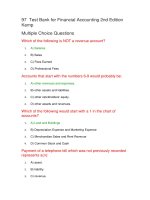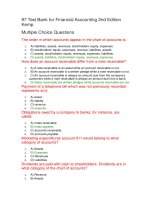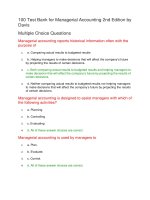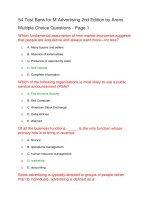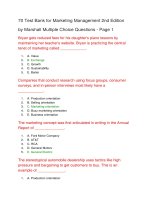Test bank for pathology for massage therapists 2nd edition salvo
Bạn đang xem bản rút gọn của tài liệu. Xem và tải ngay bản đầy đủ của tài liệu tại đây (36.26 KB, 5 trang )
buy this full document at
Salvo: Mosby’s Pathology for Massage Therapists, 2nd Edition
Chapter 01: Disease Awareness and Infection Control
Test Bank
MULTIPLE CHOICE
1. Which of the following is the study of disease?
a. Physiology
b. Pathology
c. Pharmacology
d. Psychology
ANS: B
2.
a.
b.
c.
d.
Which of the following is any illness characterized by certain signs and symptoms?
Disease
Handicap
Liability
Disorder
ANS: A
3. What is the evaluation of signs and symptoms, physical examination, and other
procedures leading to disease identification?
a. Hypothesis
b. Diagnosis
c. Palpation
d. Determination
ANS: B
4. What are objective indicators of disease that can be observed and measured, such as
swelling, skin rashes, fever, and high blood pressure?
a. Signs
b. Syndrome
c. Symptoms
d. Diagnosis
ANS: A
buy this full document at
Full file at />5. What are subjective feelings of which only the person experiencing them is aware, such as
headaches, nausea, pain, and anxiety?
a. Situation
b. Syndrome
c. Signs
d. Symptoms
ANS: D
6. A group of signs and symptoms occurring together to present a particular disease or
abnormality is called a(n):
a. Etiology
b. Complication
c. Syndrome
d. Risk factor
ANS: C
7.
a.
b.
c.
d.
Disease that is distributed throughout the body is called:
Chronic
Systemic
Acute
Contagious
ANS: B
8. Which of the following describes diseases that have an abrupt onset of severe signs and
symptoms and run a brief course and then resolve or can bring death?
a. Acute
b. Local
c. Chronic
d. Delayed
ANS: A
9. Which of the following describes diseases that develop gradually and last longer than six
months up to a lifetime?
a. Acute
b. Local
c. Chronic
d. Delayed
ANS: C
Copyright © 2009 by Mosby, Inc., an affiliate of Elsevier Inc.
Full file at />10. A period of partial or complete disappearance of the signs and symptoms of chronic
disease is called a:
a. Flare-up
b. Complication
c. Remission
d. Syndrome
ANS: C
11. Which of the following describes a period of increased signs and symptoms?
a. Remission
b. Exaggeration
c. Syndrome
d. Exacerbation
ANS: D
12. When the body mistakes its own tissues for something foreign:
a. The body attacks that tissue, other tissues then get attacked, and the immune
system is depleted.
b. The immune system teaches itself to recognize the tissue as normal and will never
mistake the tissue again.
c. The immune system shuts down.
d. The person will never experience remission of symptoms.
ANS: A
13. A communicable disease is a(n):
a. Disease for which much research and communication exists
b. Disease caused by disruption in metabolism
c. Disease that is inherited
d. Infectious disease
ANS: D
14. Infectious agents can be spread through:
a. Contact with contaminated linens
b. Contact with contaminated massage tools
c. Contact with open containers of lubricant or dispensers that are not properly
cleaned between clients
d. All of the above
ANS: D
Copyright © 2009 by Mosby, Inc., an affiliate of Elsevier Inc.
Full file at />15. Which of the following is an organism in which pathogens reside?
a. Reservoir
b. Cistern
c. Host
d. Hiatus
ANS: C
16. Which of the following is the source of infection, living or inanimate?
a. Cistern
b. Hiatus
c. Host
d. Reservoir
ANS: D
17. Which of the following is a biological agent capable of causing disease?
a. Aseptic agent
b. Contamination
c. Pathogen
d. Fomite
ANS: C
18. What occurs when a pathogen resides in or on an organism?
a. Microbial migration
b. Contamination
c. Exacerbation
d. Disease restoration
ANS: B
19. Which of the following is NOT an example of direct physical contact for pathogens?
a. Intact skin
b. Broken skin
c. Ingestion
d. Mucous membranes
ANS: C
Copyright © 2009 by Mosby, Inc., an affiliate of Elsevier Inc.
Full file at />20. Which of the following choices is NOT one of the body’s natural defense mechanisms
against exposure to pathogens?
a. Inflammation
b. Zinc
c. Immune response
d. Physical and chemical barriers
ANS: B
21. What is the application of measures to promote a healthful, disease-free environment?
a. Sepsis
b. Disinfection
c. Sanitation
d. Sterilization
ANS: C
22. When a therapist feels symptoms of a cold or contagious illness, he or she should:
a. Wear a mask or bandana over his or her nose and mouth to reduce the spread of
airborne particles
b. Wear gloves to reduce the spread of infection
c. Cancel appointments and offer to reschedule, or refer the client to an associate
d. Be sure to have an antimicrobial agent available in the treatment room
ANS: C
23. Causative factors or origins of disease are its:
a. Radiology
b. Entomology
c. Ideology
d. Etiology
ANS: D
24. If the disease does not have a known cause, it is called:
a. Ironic
b. Idiopathic
c. Systemic
d. Telepathic
ANS: B
Copyright © 2009 by Mosby, Inc., an affiliate of Elsevier Inc.
